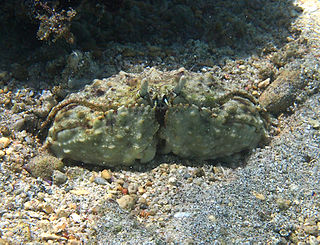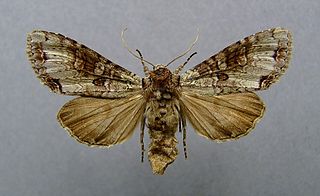
Hepatica is a genus of herbaceous perennials in the buttercup family, native to central and northern Europe, Asia and eastern North America. Some botanists include Hepatica within a wider interpretation of Anemone.

Fasciolosis is a parasitic worm infection caused by the common liver fluke Fasciola hepatica as well as by Fasciola gigantica. The disease is a plant-borne trematode zoonosis, and is classified as a neglected tropical disease (NTD). It affects humans, but its main host is ruminants such as cattle and sheep. The disease progresses through four distinct phases; an initial incubation phase of between a few days up to three months with little or no symptoms; an invasive or acute phase which may manifest with: fever, malaise, abdominal pain, gastrointestinal symptoms, urticaria, anemia, jaundice, and respiratory symptoms. The disease later progresses to a latent phase with less symptoms and ultimately into a chronic or obstructive phase months to years later. In the chronic state the disease causes inflammation of the bile ducts, gall bladder and may cause gall stones as well as fibrosis. While chronic inflammation is connected to increased cancer rates, it is unclear whether fasciolosis is associated with increased cancer risk.

Fasciola hepatica, also known as the common liver fluke or sheep liver fluke, is a parasitic trematode of the class Trematoda, phylum Platyhelminthes. It infects the livers of various mammals, including humans, and is transmitted by sheep and cattle to humans all over the world. The disease caused by the fluke is called fasciolosis or fascioliasis, which is a type of helminthiasis and has been classified as a neglected tropical disease. Fasciolosis is currently classified as a plant/food-borne trematode infection, often acquired through eating the parasite's metacercariae encysted on plants. F. hepatica, which is distributed worldwide, has been known as an important parasite of sheep and cattle for decades and causes significant economic losses in these livestock species, up to £23 million in the UK alone. Because of its relatively large size and economic importance, it has been the subject of many scientific investigations and may be the best-known of any trematode species. F. hepatica's closest relative is Fasciola gigantica. These two flukes are sister species; they share many morphological features and can mate with each other.

Calappa hepatica, the reef box crab, is a common benthic species of box crab of tropical and subtropical parts of the Indian and Pacific Oceans and the Red Sea.

Fasciola, commonly known as the liver fluke, is a genus of parasitic trematodes. There are three species within the genus Fasciola: Fasciola nyanzae,Fasciolahepatica and Fasciolagigantica. Fasciola hepatica and F. gigantica are known to form hybrids. Both F. hepatica and F. gigantica and their hybrids infect the liver tissue of a wide variety of mammals, including humans, in a condition known as fascioliasis. F. hepatica measures up to 30 mm by 15 mm, while F. gigantica measures up to 75 mm by 15 mm. Fasciola nyanzae is thought to exclusively infect the common hippopotamus, Hippopotamus amphibius.

Fasciola gigantica is a parasitic flatworm of the class Trematoda, which causes tropical fascioliasis. It is regarded as one of the most important single platyhelminth infections of ruminants in Asia and Africa. The infection is commonly called fasciolosis.

Tribendimidine is a broad-spectrum anthelmintic agent developed in China, at the National Institute of Parasitic Diseases in Shanghai. It is a derivative of amidantel.

The hepatic tanager is a medium-sized American songbird. Formerly placed in the tanager family (Thraupidae), it and other members of the genus Piranga are now classified in the cardinal family (Cardinalidae).

Galba truncatula is a species of air-breathing freshwater snail, an aquatic pulmonate gastropod mollusk in the family Lymnaeidae, the pond snails.

Anemone hepatica, the common hepatica, liverwort, liverleaf, kidneywort, or pennywort, is a species of flowering plant in the buttercup family Ranunculaceae, native to woodland in temperate regions of the Northern Hemisphere. This herbaceous perennial grows from a rhizome.

Capillaria hepatica is a parasitic nematode which causes hepatic capillariasis in rodents and numerous other mammal species, including humans. The life cycle of C. hepatica may be completed in a single host species. However, the eggs, which are laid in the liver, must mature outside of the host body prior to infecting a new host. Death and decomposition of the host in which the adults reach sexual maturity are necessary for completion of the life cycle.
Hepatica is a genus of moths of the family Noctuidae. The genus was described by Staudinger in 1892.

Polia hepatica, the silvery arches, is a moth of the family Noctuidae. The species was first described by Carl Alexander Clerck in 1759. It is found in temperate Europe and east across the Palearctic to Siberia and Korea. It is not present in northernmost Fennoscandia and the southern parts of the Iberian Peninsula, Italy and Greece. It is also absent from Japan.

Acalolepta is a genus of flat-faced longhorns beetle belonging to the family Cerambycidae, subfamily Lamiinae. Its members are found in the Indomalayan realm.

HMCS Hepatica was a Flower-class corvette that served primarily with the Royal Canadian Navy during the Second World War. She saw service in the Battle of the Atlantic as an ocean escort. Originally commissioned into the Royal Navy, she was loaned to Canada in 1941.

Sal Hepatica is the name of a mineral salt laxative that was produced and marketed by Bristol-Myers from its inception in 1887, becoming its first nationally recognized product in 1903, until 1958. When dissolved in water, it was said to reproduce the taste and effect of the natural mineral waters of Bohemia.

Hepatica acutiloba, the sharp-lobed hepatica, is a herbaceous flowering plant in the buttercup family Ranunculaceae. It is sometimes considered part of the genus Anemone, as Anemone acutiloba, A. hepatica, or A. nobilis.
Acalolepta rusticatrix is a species of beetle in the family Cerambycidae. It was described by Johan Christian Fabricius in 1801, originally under the genus Lamia. It is known from Myanmar, India, the Philippines, Malaysia, Sumatra, Sri Lanka, Java, Taiwan, Indonesia, Sulawesi, and Vietnam.

Alysse was one of the nine Flower-class corvettes lent by the Royal Navy to the Free French Naval Forces.

Hepatica transsilvanica, called the large blue hepatica, is a species of flowering plant in the genus Hepatica, native to the Carpathian Mountains of Romania. It has gained the Royal Horticultural Society's Award of Garden Merit.














